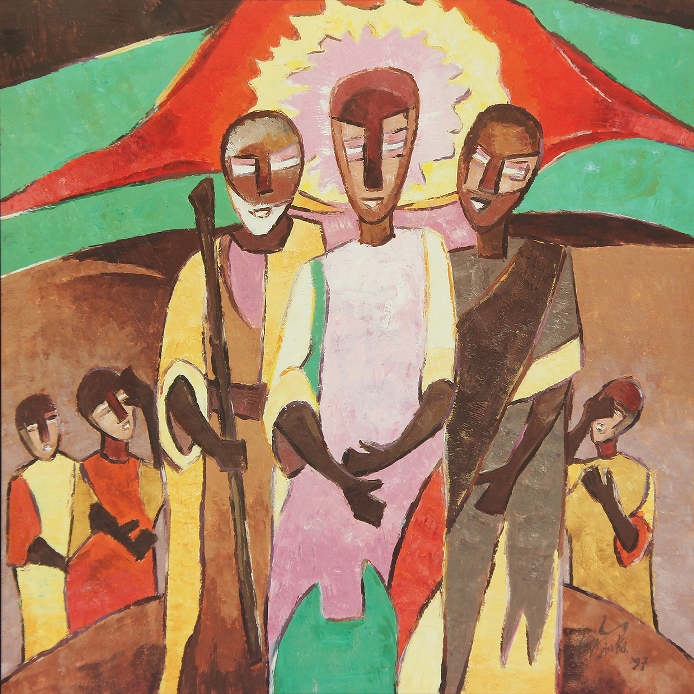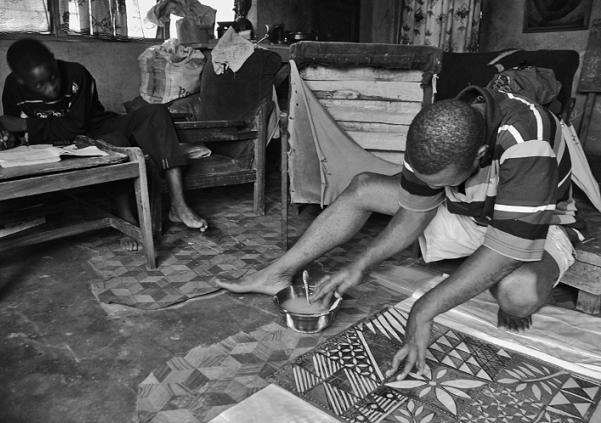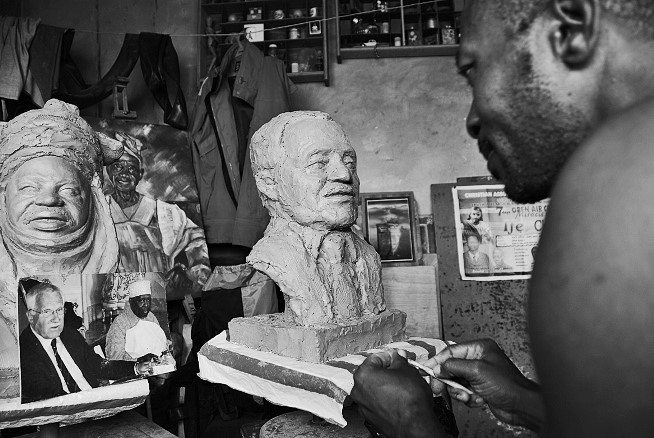Olayinka, Augustin K. - VM - Christian Weber
Augustin Kolawole Olayinka: The Transfiguration

Jesus Leads us to the End of History
by Christian Weber
The perspective of this image is striking in comparison to most of the representations of the Transfiguration of Jesus: the foreground does not show the disciples kneeling or lying but Jesus coming towards the viewer, followed by Moses and Elijah. Three disciples stand in the background further down on the mountain. They see the apparition only from behind, looking at the back of the divine reality (cf. Ex 33:23). Two of them hold one of their hands in front of their eyes to protect themselves from the blinding light.
Moses and Elijah do not stand next to Jesus, they are not in conversation with him, but walk behind him as his followers. Moses carries the stick he performed miracles with (Ex 4:2) and the belt of the Passover (Ex 12:11). Elijah carries a simple prophet's robe of camel hair (2 Kings 1:8), while the flames at the bottom of his robe may refer to God's miraculous fire on Mount Carmel.
The colour scheme is striking: warm earth colours of brown and ochre predominate. The green and red of the sky are reflected in the garment of Jesus. His halo and the upper part of his robe are pink. And does the green patch at the bottom of his robe perhaps refer to the devil, who Christ will be facing soon in the evil of the cross?
In the artist's perspective the story of the Transfiguration not only tells about Jesus showing himself to the disciples. Jesus comes towards us, he invites us to follow him and join his followers of different ages – until the end of history.
*******
1. Augustin Kolawole Olayinka: The Transfiguration of Jesus (1997). From: missio-Kunstkalender 2002 no. 5 © missio Aachen.
2. Olayinka uses a selfmade stencil to put paste on the cloth. His second son is watching him.
Photo: Shirabe Ogata (2010). From: Ogata (2016) 586, fig. 25.
3. Olayinka working on clay statues. Photo: Shirabe Ogata (2008). From: Ogata (2016) 607, fig. 36.


Augustin Kolawole Olayinka was born in Ibadan/Nigeria in 1964 and discovered his artistic abilities as a child. Through the mediation of an uncle he was able to take an apprenticeship with the artist Bayo Ogundele in Ile-Ife. Like his famous brother Rufus Ogundele, Bayo belonged to the Oshogbo School, which was founded in the mid-1960s by Georgina and Ulli Beier (she was a painter from England and he a linguist from Germany). Typical for the Oshogbo style are flat compositions, use of primary colours, representation of faces like African masks and themes from Yoruba culture (like mythology, dance and agriculture). In 1986 Olayinka passed the entrance examination of the university in Ile-Ife and was able to study art for four years. When he won the missio Art Prize in 1993, he was invited to Aachen, Germany for three months and gained international recognition. But it remained difficult to make a living from art. At times he earned money as a motorcycle taxi driver. Between 2008 and 2012 he received several commissions to decorate Catholic churches in Nigeria. Even though his wife Funke has a small tailor shop and trades in food, the money was not enough to finance a higher education of their two sons and three daughters. At times the family could only afford one meal a day. Together with his family, Olayinka belongs to a Pentecostal church founded in 2006, where he is also active as a choir conductor and Sunday school teacher. He continues to make a living from artistic commissions, which include an enormous range of styles and techniques (painting, fabric printing, clay reliefs, cement statues).
Literature:
- missio-Kunstkalender (1995) no. 9, (2002) and (2007) no. 2
- Gregor von Fürstenberg and Vellguth, Klaus (Ed.) (2006): Mein Bild von Weihnachten. Was Prominente glauben, Kevelaer, 13.
- Gregor von Fürstenberg and Vellguth, Klaus (Ed.) (2007): Mein Bild von Ostern. Was Prominente glauben, Kevelaer, 11.
- Shirabe Ogata (2016):「アーティスト」として生きていく= To Live as an Artist. The Way the Arts are Practiced in the City of Ile-Ife, Nigeria, in: Bulletin of the National Museum of Ethnology Osaka/Japan 40 (2016, vol. 4) 547-618. [doi.org/10.15021/00006074]
This essay is an extended excerpt from: Weber, Christian (2020): Wie andere Kulturen die Bibel sehen. Ein Praxisbuch mit 70 Kunstwerken aus 33 Ländern, Zürich [How Other Cultures See the Bible. A Handbook with 70 Artworks from 33 Countries], www.tvz-verlag.ch/buch/wie-andere-kulturen-die-bibel-sehen-9783290182748/?page_id=1
ArtWay Visual Meditation 2 August 2020


